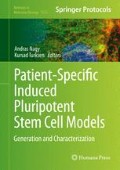Abstract
Induced pluripotent stem cell (iPSC) technology has allowed for the invaluable modeling of many genetic disorders including disorders associated with genomic imprinting. Genomic imprinting involves differential DNA and histone methylation and results in allele-specific gene expression. Most of the epigenetic marks in somatic cells are erased and reestablished during the process of reprogramming into iPSCs. Therefore, in generating models of disorders associated with genomic imprinting, it is important to verify that the imprinting status and allele-specific gene expression patterns of the parental somatic cells are maintained in their derivative iPSCs. Here, we describe three techniques: DNA methylation analysis, allele-specific PCR, and RNA FISH, which we use to analyze genomic imprinting in iPSC models of neurogenetic disorders involving copy number variations of the chromosome 15q11–q13 region.
Access this chapter
Tax calculation will be finalised at checkout
Purchases are for personal use only
References
Henckel A, Arnaud P (2010) Genome-wide identification of new imprinted genes. Brief Funct Genomics 9(4):304–314
Gregg C et al (2010) High-resolution analysis of parent-of-origin allelic expression in the mouse brain. Science 329(5992):643–648
Kelsey G, Bartolomei MS (2012) Imprinted genes … and the number is? PLoS Genet 8(3):e1002601
Singh P et al (2011) Chromosome-wide analysis of parental allele-specific chromatin and DNA methylation. Mol Cell Biol 31(8):1757–1770
Chamberlain SJ, Lalande M (2010) Neurodevelopmental disorders involving genomic imprinting at human chromosome 15q11-q13. Neurobiol Dis 39(1):13–20
Jacob KJ, Robinson WP, Lefebvre L (2013) Beckwith-Wiedemann and Silver-Russell syndromes: opposite developmental imbalances in imprinted regulators of placental function and embryonic growth. Clin Genet 84(4):326–334
Nakabayashi K et al (2002) Identification and characterization of an imprinted antisense RNA (MESTIT1) in the human MEST locus on chromosome 7q32. Hum Mol Genet 11(15):1743–1756
Davies SJ, Hughes HE (1993) Imprinting in Albright hereditary osteodystrophy. J Med Genet 30(2):101–103
Chamberlain SJ, Li XJ, Lalande M (2008) Induced pluripotent stem (iPS) cells as in vitro models of human neurogenetic disorders. Neurogenetics 9(4):227–235
Chamberlain SJ et al (2010) Induced pluripotent stem cell models of the genomic imprinting disorders Angelman and Prader-Willi syndromes. Proc Natl Acad Sci U S A 107(41):17668–17673
Germain ND, Chen P-F, Plocik AM, Glatt-Deeley H, Brown J, Fink JJ, Bolduc KA, Robinson TM, Levine ES, Reiter LT, Graveley BR, Lalande M, Chamberlain SJ (2014) Gene expression analysis of human induced pluripotent stem cell-derived neurons carrying copy number variants of chromosome 15q11-q13.1. Mol Autism 5:44
Martins-Taylor K et al (2014) Imprinted expression of UBE3A in non-neuronal cells from a Prader-Willi syndrome patient with an atypical deletion. Hum Mol Genet 23(9):2364–2373
Yamada Y et al (2004) A comprehensive analysis of allelic methylation status of CpG islands on human chromosome 21q. Genome Res 14(2):247–266
Bruce S, Hannula-Jouppi K, Lindgren CM, Lipsanen-Nyman M, Kere J (2008) Restriction site-specific methylation studies of imprinted genes with quantitative real-time PCR. Clin Chem 54(3):491–499
Oakes CC, La Salle S, Robaire B, Trasler JM (2006) Evaluation of a quantitative DNA methylation analysis technique using methylation-sensitive/dependent restriction enzymes and real-time PCR. Epigenetics 1(3):146–152
Chomczynski P, Sacchi N (1987) Single-step method of RNA isolation by acid guanidinium thiocyanate-phenol-chloroform extraction. Anal Biochem 162(1):156–159
Shirk RY, Glenn TC, Chang S-M, Hamrick J (2013) Development and characterization of microsatellite primers in Geranium carolinianum (Geraniaceae) with 454 sequencing. Appl Plant Sci 1(8)
Untergasser A et al (2012) Primer3—new capabilities and interfaces. Nucleic Acids Res 40(15):e115
Koressaar T, Remm M (2007) Enhancements and modifications of primer design program Primer3. Bioinformatics 23(10):1289–1291
Kishino T, Wagstaff J (1998) Genomic organization of the UBE3A/E6-AP gene and related pseudogenes. Genomics 47(1):101–107
Ferrandiz C, Sessions A (2008) Preparation and hydrolysis of digoxigenin-labeled probes for in situ hybridization of plant tissues. CSH Protoc 2008:pdb prot4942
Author information
Authors and Affiliations
Corresponding author
Editor information
Editors and Affiliations
Rights and permissions
Copyright information
© 2014 Springer Science+Business Media New York
About this protocol
Cite this protocol
Chamberlain, S.J., Germain, N.D., Chen, PF., Hsiao, J.S., Glatt-Deeley, H. (2014). Modeling Genomic Imprinting Disorders Using Induced Pluripotent Stem Cells. In: Nagy, A., Turksen, K. (eds) Patient-Specific Induced Pluripotent Stem Cell Models. Methods in Molecular Biology, vol 1353. Humana Press, New York, NY. https://doi.org/10.1007/7651_2014_169
Download citation
DOI: https://doi.org/10.1007/7651_2014_169
Published:
Publisher Name: Humana Press, New York, NY
Print ISBN: 978-1-4939-3033-3
Online ISBN: 978-1-4939-3034-0
eBook Packages: Springer Protocols

